Iomega ix4-200r User Manual

WHITE PAPER
USING IOMEGA STORCENTER
PRO ix4-200r NAS SERVER WITH
VMWARE ESX SERVER 3.5
|
|
Introduction |
2 |
Audience |
3 |
Terminology |
3 |
Solution Configuration |
3 |
Hardware |
3 |
Software |
4 |
Deployment Roadmap |
4 |
NIC & SCSI Initiator Configuration |
5 |
VMkernel Port Configuration |
5 |
Adding a Share on StorCenter |
8 |
Creating a NFS Datastore on ESX Server |
11 |
Adding an iSCSI LUN on StorCenter |
15 |
Creating a VMFS Datastore on ESX Server |
17 |
Adding an RDM Disk to Virtual Machine |
24 |
Multipathing & Failover Considerations |
28 |
Conclusion |
28 |
APRIL 2009

STORCENTER IX4-200r NAS WITH VMWARE ESX SERVER 3.5
EXECUTIVE SUMMARY
VMware® ESX Server is virtual infrastructure software for consolidating and managing systems. ESX Server accelerates service deployments and adds management flexibility by partitioning x86 servers into a pool of secure, portable and hardware-independent virtual machines. VMware Virtual Infrastructure and ESX Server have gained tremendous attraction and acceptance in the industry and are considered critical IT components for enterprises and small businesses alike.
Iomega® StorCenter™ Pro ix4-200r NAS Server is an integrated storage device that offers both NAS and iSCSI functionality to allow customers flexible deployment options. The product targets smallto medium-sized businesses with a rich set of features and simplicity of management. The StorCenter ix4-200r is powered by EMC® LifeLineTM software to allow businesses to protect and share data with EMC’s world class storage and security technologies.
This white paper examines how StorCenter ix4-200r can be used to present storage to VMware ESX Server in a virtual environment. The paper also provides detailed procedures that illustrate how to create storage on a StorCenter ix4200r in different forms and then utilize the storage on a VMware ESX Server.
INTRODUCTION
VMware Infrastructure 3 supports NAS storage devices using the NFS and iSCSI protocols. StorCenter NAS devices can present NFS-exported shares and iSCSI LUNs to VMware ESX Server to create Datastores for virtual machines and virtual disks. An Iomega StorCenter NAS offers greater reliability, ease of use, and ease of management characteristics that are designed specifically for the needs of small businesses.
VMware ESX Server can connect to iSCSI targets using either software or hardware iSCSI initiators. The LUNs presented by a target can then be formatted in the proprietary VMFS format. VMware ESX can also use iSCSI LUNs in the form of RDM to provide direct raw disk access to virtual machines. VMFS is the native storage option on VMware ESX Server, It’s also how SAN storage and local disks are utilized to create datastores.
NFS is another compelling option for VMware ESX for many reasons. With NFS, VMWare ESX Server supports advanced features including VMotion, Distributed Resource Scheduler (DRS), high availability (VMHA), and VMware Consolidated Backup (VCB). NFS offers a highly simplified management model that reduces cost and management complexity. VMware encapsulates virtual machines into a small number of .vmdk files. NFS is an optimized file-serving protocol with operational granularity at the file level as opposed to the LUN level.
Iomega StorCenter NAS satisfies requirements for both storage options on VMware ESX Server and is certified in the VMware Hardware Compatibility List (HCL) with certifications in both NAS and Software iSCSI categories. A StorCenter NAS device is a proven storage platform for small businesses that want to deploy VMware ESX Server.
White Paper |
2 |

STORCENTER IX4-200r NAS WITH VMWARE ESX SERVER 3.5
AUDIENCE
Information contained in this white paper is intended for Iomega customers, partners, and service personnel involved in planning, architecting, or administering a VMware environment with an Iomega StorCenter NAS as the storage device. The readers are expected to have experience with ESX Server and an Iomega StorCenter NAS devices that run EMC Lifeline software.
TERMINOLOGY
t Datastore: A file system, either VMFS or NFS, that serves as a virtual representation of an underlying pool of physical storage resources. These physical storage resources can be comprised of SCSI disks from a local server, Fibre Channel SAN disk arrays, iSCSI SAN disk arrays, or NAS storage arrays.
t Internet SCSI (iSCSI): A protocol for sending SCSI packets over TCP/IP networks.
t iSCSI LUN: iSCSI LUN (Logical Unit Number) is a virtual disk that processes SCSI commands, such as reading from and writing to storage media.
t Network File System (NFS): A distributed file system providing transparent access to remote file systems. NFS allows all network systems to share a single copy of a directory.
t Raw Device Mapping (RDM): RDM includes a combination of a pointer, which is a .vmdk file that resides on a VMFS volume, and a physical raw device that the .vmdk file points to. RDM can either be physical compatibility mode or virtual compatibility mode.
t Virtual Machine: A virtualized x86 PC on which a guest operating system and an associated application run. A VM is also a set of discrete files that primarily include a .vmx configuration file and one or more .vmdk virtual disk files.
t Virtual Machine File System (VMFS): A VMware proprietary file system installed onto data stores and used by ESX Server to house virtual machines.
SOLUTION CONFIGURATION
This section lists hardware and software resources for provisioning StorCenter ix4-200r storage to VMware ESX Server 3.5, as illustrated in this white paper.
HARDWARE
Table 1 lists the hardware resources used in the testing environment for the paper
Hardware |
Quantity |
Configuration |
|
Iomega® StorCenter™ Pro |
one |
•Four 500 GB or 1TB (7200 rpm) SATA disks |
|
NAS ix4-200r NAS |
|
•RAID 5 across the disks |
|
|
|
•One GbE network connection |
|
Dell PowerEdge 1850 |
one |
•Two Intel Xeon 3.00GHz CPUs |
|
|
|
•8 GB of memory |
|
|
|
•One 146 GB 15k internal SCSI disk |
|
|
|
•Four 10/100/1000 MB Ethernet NICs |
|
|
|
|
White Paper |
3 |
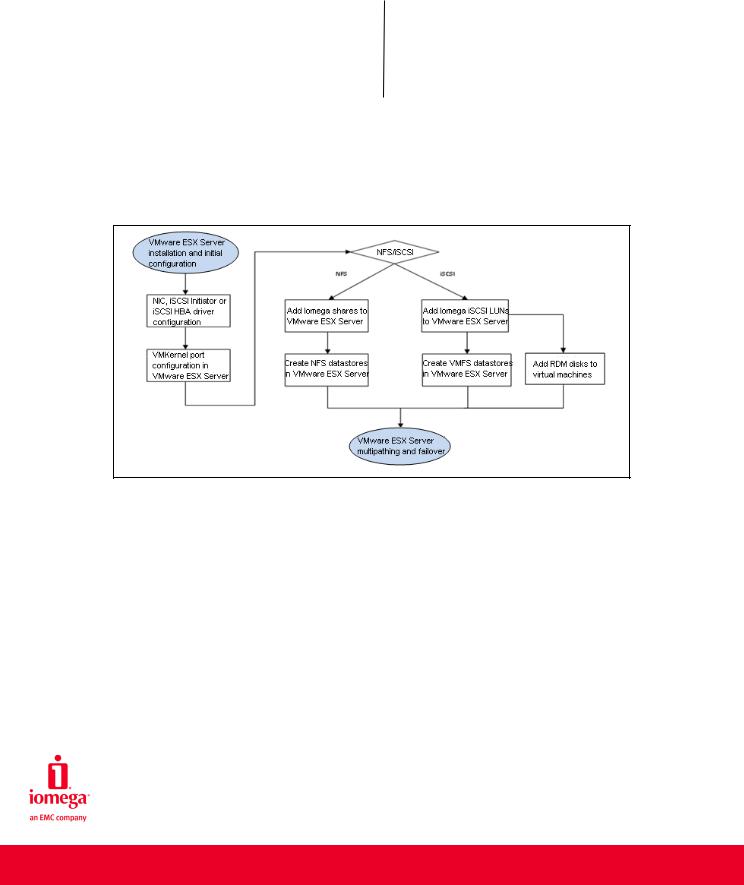
STORCENTER IX4-200r NAS WITH VMWARE ESX SERVER 3.5
SOFTWARE
Table 2 lists the software resources used in the testing environment.
Software |
Quantity |
Configuration |
|
EMC Lifeline 2.0 |
one |
EMC firmware that runs the Iomega |
|
|
|
StorCenter Pro ix4-200r NAS |
|
VMware ESX Server 3.5 |
one |
Installed on a Dell PowerEdge 1850 |
|
|
|
machine |
|
VMware Virtual Infrastructure 2.0 |
one |
Installed on a Windows client |
|
|
|
|
DEPLOYMENT ROADMAP
Following its installation and initial configuration, the ESX Server can be connected to shared storage that is presented from the StorCenter ix4-200r over the NFS and the iSCSI network protocols. Figure 1 highlights the steps that should be followed when connecting the StorCenter ix4-200r storage device to the ESX Server.
Figure 1 High-level roadmap for connecting the ESX Server to a StorCenter ix4-200r
This white paper provides further information on each of these steps as follows:
w NIC and iSCSI initiator configuration in the ESX Server – configuring the physical NIC, software iSCSI initiator or the iSCSI HBA that will be used to connect the ESX Server to a StorCenter ix4-200r.
w VMkernel port configuration in the ESX Server – configuring the ESX Server for IP storage connections to a StorCenter ix4-200r for both the NFS and iSCSI network storage protocols.
w Adding Iomega shares to the ESX Server – for NFS, creating and exporting Iomega shares to the ESX Server.
w Creating NFS datastores in the ESX Server – for NFS, configuring NFS datastores in the ESX Server on the exported shares from a StorCenter ix4-200r.
w Adding iSCSI LUNs to the ESX Server – for iSCSI, creating and sharing Iomega iSCSI LUNs to the ESX Server.
White Paper |
4 |
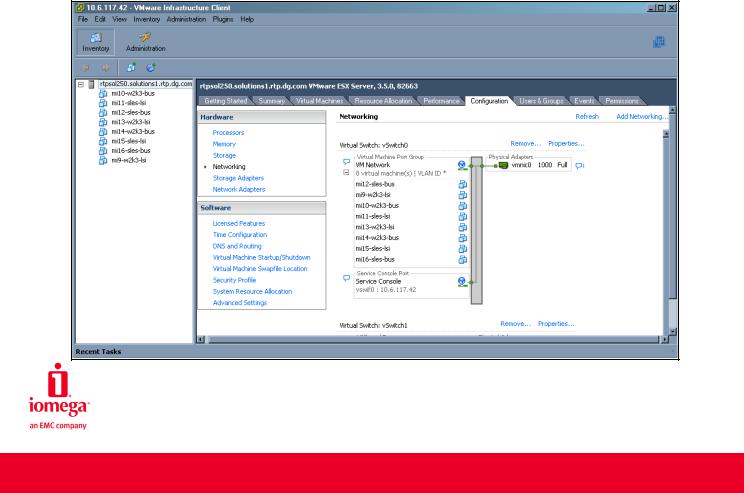
STORCENTER IX4-200r NAS WITH VMWARE ESX SERVER 3.5
w Creating VMFS datastores in the ESX Server – for iSCSI, configuring VMFS datastores over the iSCSI LUNs that were provisioned from a StorCenter ix4-200r.
w Adding RDM disks to virtual machines – for iSCSI, alternatively making the LUNs available as RDM disks to the virtual machines.
w Multipathing and failover in the ESX Server – best practices for designing highly available network architecture in the ESX Server.
NIC AND ISCSI INITIATOR CONFIGURATION
The NIC and iSCSI HBA drivers provided by VMware as part of the ESX Server distribution should be utilized when connecting the ESX Server to a StorCenter ix4-200r storage device.
For iSCSI, both the ESX Server software iSCSI initiator and the iSCSI HBA can be used to connect to StorCenter ix4200r iSCSI targets. When using iSCSI HBA, two models by QLogic are currently supported. They are QLA4050c and QLE4060c; both are certified in the VMware I/O Compatibility Guide for ESX Server 3.5 (http://www.vmware.com/pdf/vi35_io_guide.pdf).
VMKERNEL PORT CONFIGURATION
A VMkernel port allows for the usage of both iSCSI and NFS storage. When the storage has been configured on a StorCenter ix4-200r, the ESX server host must have a VMkernel port defined with network access to the Iomega device.
1.Click Configuration >Networking > Add Networking.
Figure 2 Add network
White Paper |
5 |
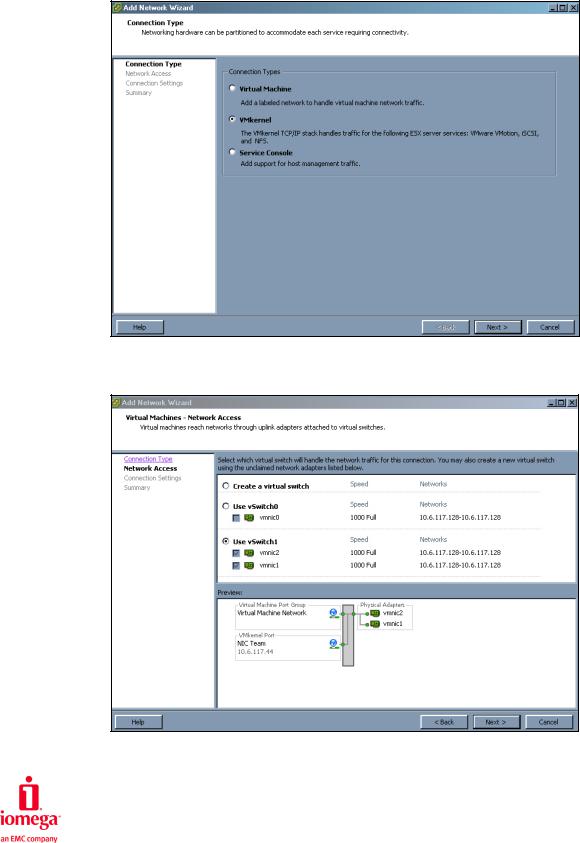
STORCENTER IX4-200r NAS WITH VMWARE ESX SERVER 3.5
2. Select the VMkernel connection type as shown in Figure 3.
Figure 3 VMkernel selection
3. Select a virtual switch to handle the VMkernel port traffic
Figure 4 Select virtual switch
White Paper |
6 |
|
|
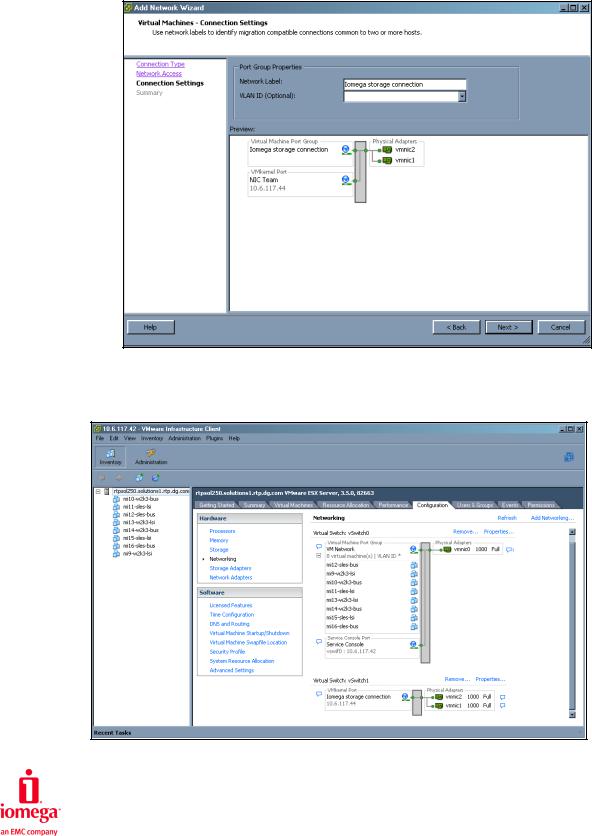
STORCENTER IX4-200r NAS WITH VMWARE ESX SERVER 3.5
4. Name the new VMkernel port group and optionally the VLAN ID for the network.
Figure 5 Name the VMkernel port group
5. Verify the settings and finish creating the VMkernel port.
Figure 6 VMkernel port group created
White Paper |
7 |
|
|
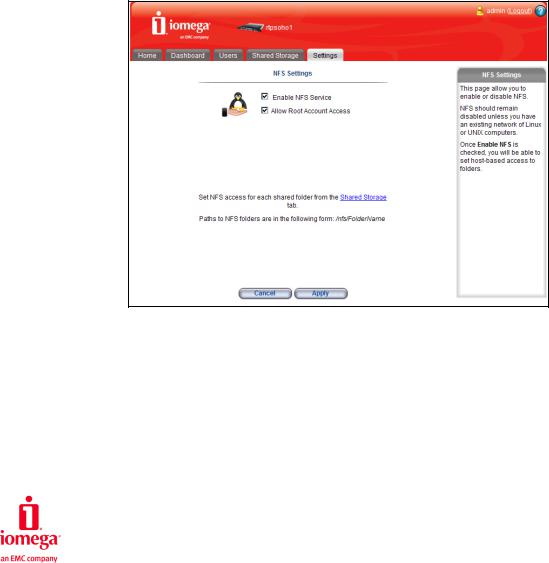
STORCENTER IX4-200r NAS WITH VMWARE ESX SERVER 3.5
ADDING A SHARE ON AN IOMEGA STORCENTER NAS DEVICE
When using NFS storage, you need to add a share on a StorCenter ix4-200r. Appropriate access permissions must be set for the VMkernel port on the ESX Server to mount an NFS share. These access permissions are:
w Host access – provide the VMkernel port mount access to the share.
w Read/write access – provide the VMkernel port read/write access to the share. w Root access – provide the VMkernel port root access to the share.
NFS exports directories with root_squash turned on. This means that root on the client machine will be mapped to the anonymous UID, which is commonly nobody. The result is that root on the client machine will not be able to access anything in the exported entry. The no_root_squash option prevents this behavior. Therefore, if you want to secure the share to be used by ESX, you must enable root account access on your Lifeline. If you choose to leave the share nonsecured, then nothing special needs to be done.
1. From Settings > Network Services > check Enable NFS Service on StorCenter ix4-200r. Also, check “Allow Root Account Access” if you intend to secure the NFS share so that the ESX server can access it using the default root account.
Figure 7 Enable NFS service on the StorCenter ix4-200r
White Paper |
8 |
|
|
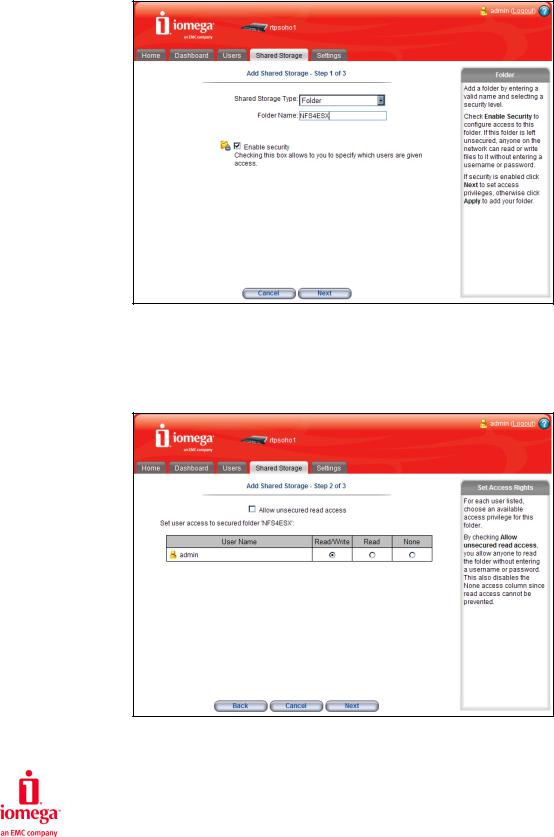
STORCENTER IX4-200r NAS WITH VMWARE ESX SERVER 3.5
2.Go to Shared Storage and click Add to create a new share and optionally enable security on it.
Figure 8 Create a new share
When creating the share, ensure Folder is the shared storage type and that Enable security is not checked.
3.Click Next to specify user access to the secured share.
Figure 9 Specify user access
White Paper |
9 |
|
|
